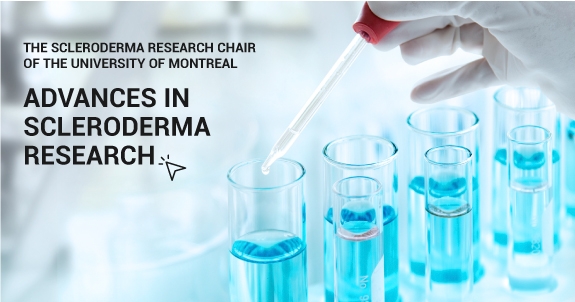Scleroderma Research Chair
THE SCLERODERMA RESEARCH CHAIR OF THE UNIVERSITY OF MONTREAL
- The Chair – what exactly is it?
First and foremost, it is a public recognition of the importance of scleroderma as a serious disease in society, and of the need to conduct medical research at the highest level to better understand the mechanisms of the disease and develop new treatments.
At the initiative of Scleroderma Quebec, the Chair was established in the early 2000s. The signatories to the Chair agreement are the University of Montreal and its Faculty of Medicine, the University of Montreal Health Centre (CHUM), the CHUM Research Centre (CRCHUM) and Scleroderma Quebec.
Financially, the Chair is a capitalized fund worth $1.6M at the University of Montreal, with interest paid annually to the Chairholder to finance research. Initially, the Chair was set up thanks to donations from the CHUM, the Faculty of Medicine of the University of Montreal, and thanks in particular to individual donations from patients and the public collected by Scleroderma Quebec.
- What are the objectives of the Chair?
The main objective is to improve the quality of life and life expectancy of scleroderma patients.
To achieve this objective, the Chair uses the following means:
- expand and accelerate clinical research (with patients) and high-level fundamental research (in the laboratory),
- attract the best doctors and researchers,
- ensure the sustainability and continuity of research.
- Who is the Chairholder?
The incumbent is Jean-Luc Senécal, MD, FRCPC, Full Professor in the Department of Medicine at the Faculty of Medicine of the University of Montreal, rheumatologist at the CHUM and researcher at the CRCHUM. The Chair’s research activities are located in Montreal at the CRCHUM and the CHUM.
- Are there any concrete examples of research discoveries and progress made as a result of the Chair?
Here are some examples, published in the best international medical journals.
First description of scleroderma in French Canada. This study, which involved more than 300 patients, described scleroderma in Quebec and made it possible to identify certain manifestations at the time of diagnosis that are strongly suggestive of a high mortality risk. The attending medical team can, therefore, intensify treatment and follow-up for those at risk, to improve their life expectancy (1).
Identification of predictive factors of scleroderma in patients with isolated Raynaud’s disease. This major groundbreaking study uses scleroderma-typical circulating autoantibodies and nailfold capillary abnormalities detected by capillaroscopy to identify several years in advance people who are developing scleroderma. This study therefore makes it possible to diagnose the disease at an early stage – “prescleroderma” – and opens the door to new treatments which will stop scleroderma in its tracks from the onset (2).
Anti-centromere autoantibodies promote vascular complications of scleroderma. The four major pathophysiological mechanisms that cause scleroderma are autoimmunity (attack of the immune system on the person’s body, including in the blood the presence of autoantibodies highly specific of the disease, such as antitopoisomerase I or anti-topo), microvascular anomalies, inflammation, and fibrosis. For some unknown reason, patients with anti-centromere autoantibodies are at particular risk of severe vascular complications, such as finger ulcers, and mortality from pulmonary arterial hypertension. The research team has discovered that the immune complexes formed by the anti-centromere autoantibodies and the centromeric B protein against which they are directed, promote a slow but progressive process of vascular obliteration, thus explaining how these autoantibodies contribute to the severe vascular manifestations of scleroderma (3).
Anti-topoisomerase I autoantibodies have pro-inflammation and pro-fibrosis properties. Patients with anti-topo autoantibodies have been found to be at particular risk of death from pulmonary fibrosis, but the etiological mechanism is still unknown. The research team discovered that the immune complexes formed by anti-topo autoantibodies with the topo itself have properties that promote inflammation and fibrosis, thus explaining how circulating anti-topo contribute to the manifestations of scleroderma (4).
Copy human scleroderma in mice. One of the major scientific challenges of scleroderma is the absence of an animal model that accurately reproduces its four major mechanisms. A good animal model allows experiments that ethics would not allow in humans (such as triggering scleroderma), gives access to a higher level of biological complexity than is possible in test tubes, and allows therapeutic testing of new curative and even preventive drugs, the success of which then provides a strong scientific justification for testing in humans.
In close collaboration with Marika Sarfati, MD, PhD, of the CRCHUM’s Immunoregulation Laboratory, and thanks to a major research grant from the Canadian Institutes of Health Research, the team was able to copy human scleroderma in mice by developing a new model that reproduces its four cardinal anomalies. Using dendritic immune cells loaded with topo and injected into mice, this innovative model reproduces the production of anti-topo autoantibodies, as well as the inflammation and fibrosis of the skin and lungs typical of patients with anti-topo autoantibodies. Four weeks of scleroderma with this model is equivalent to approximately four years of human scleroderma, resulting in a major decrease in the time required with the model for future trials of new therapeutic molecules (5).
This research was also supported by Scleroderma Quebec, Scleroderma Society of Ontario, Scleroderma Society of Canada and Scleroderma Association of Saskatchewan.
- Are there any other concrete examples of the Chair’s usefulness in the fight against scleroderma?
Excellence of care. The Chair is helping to create a centre of excellence in the rheumatology department of the CHUM for the diagnosis and care of scleroderma. Patients receive the best care from their rheumatologists thanks to a highly qualified and dedicated multidisciplinary medical team at the forefront of knowledge.
Advanced teaching. All residents in the rheumatology subspecialization program learn to expertly diagnose and treat scleroderma and, at the end of their training, apply their knowledge to their rheumatological practice for the benefit of patients. No less than 35 new young rheumatologists now working in Quebec have been trained since the establishment of the Chair.
Training the next generation. The Chair awards scholarships to the best master’s and doctoral students, thereby contributing to the advancement of knowledge and ensuring that the future of scleroderma care and research is in good hands.
Acquisition of exceptional research equipment. The achievements of the Scleroderma research Chair, the excellence of its research team and its international influence have led to an exceptional private donation of $400,000 from Scleroderma Quebec to Dr. Marika Sarfati and the Chairholder. This donation, combined with a major grant from the Canada Foundation for Innovation, enabled the CRCHUM to acquire a Becton-Dickinson FACSymphony device in the fall of 2018. It is a high-end, state-of-the-art multi-parameter cellular analyzer that can determine up to 50 characteristics of a single cell. Worth $1.5M, this device has a very limited distribution in Canada. In particular, it will enable the research team to better understand, both in the experimental model and in patients, the complex molecular and cellular mechanisms of scleroderma in order to identify potential new therapeutic targets.
- References
- Scussel-Lonzetti L, Joyal F, Raynauld JP, Roussin A, Rich É, Goulet JR, Raymond JR, Senécal JL : Predicting mortality in systemic sclerosis: analysis of a cohort of 309 French Canadian patients with emphasis on features at diagnosis as predictive factors for survival. Medicine (2002) 81: 154-167.
Available free online at https://insights.ovid.com/pubmed?pmid=11889414#
- Koenig M, Joyal F, Fritzler MJ, Roussin A, Abrahamowicz M, Boire G, Goulet JR, Rich É, Grodzicky T, Raymond Y, Senécal JL. Autoantibodies and microvascular damage are independent predictive factors for the progression of Raynaud’s phenomenon to systemic sclerosis. A 20-year prospective study of 586 patients with validation of proposed criteria for early systemic sclerosis. Arthritis Rheum (2008) 58: 3902-3912.
Available free online at https://onlinelibrary.wiley.com/doi/epdf/10.1002/art.24038
- Robitaille G, *Christin MS, Clément I, Senécal JL, Raymond Y. The nuclear autoantigen centromere protein B (CENP-B) transactivates the EGF-receptor via chemokine receptor 3 in vascular smooth muscle cells. Arthritis Rheum (2009) 60:2005-2016.
Available free online at https://onlinelibrary.wiley.com/doi/epdf/10.1002/art.24765
- Arcand J, Robitaille G, Martial Koenig, Senécal JL, Raymond Y. The autoantigen DNA topoisomerase I interacts with chemokine receptor 7 and exerts cytokine-like effects on dermal fibroblasts. Arthritis Rheum (2012) 64:826-834.
Available free online at https://onlinelibrary.wiley.com/doi/epdf/10.1002/art.33377
- Mehta H, Goulet PO, Mashiko S, Desjardins J, Pérez G, Koenig K, Senécal JL, Constante M, Santos MM, Sarfati M. Exposure to antibiotic limited to early life causes intestinal dysbiosis and exacerbates skin and lung pathology in murine experimental systemic sclerosis. J Invest Derm (2017) 137:2316-2325.
Available free online at https://www.jidonline.org/article/S0022-202X(17)31854-7/pdf

